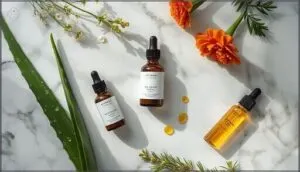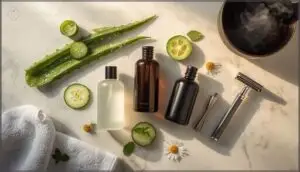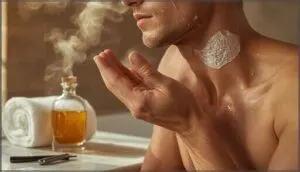This site is supported by our readers. We may earn a commission, at no cost to you, if you purchase through links.

Your face is still tingling from the razor when you reach for that bottle of aftershave—but here’s the thing: what works for your gym buddy might leave your skin red and angry. The right aftershave isn’t just about smelling good; it’s about matching the formula to your skin’s specific needs, whether you’re dealing with dryness, excess oil, or the kind of sensitivity that makes every shave feel like a gamble.
The difference between a product that soothes and one that irritates often comes down to understanding a few key ingredients and knowing what your skin is actually asking for. Once you crack the code on how to choose the right aftershave, those post-shave hours transform from damage control into genuine skin improvement.
Table Of Contents
Key Takeaways
- Your skin type—dry, oily, sensitive, or normal—determines which aftershave formula will soothe versus irritate, with balms working best for dry skin, gels for oily skin, and alcohol-free options for sensitive skin.
- Key ingredients like glycerin, aloe vera, and witch hazel provide measurable benefits such as 20-40% increased hydration and 27% faster wound healing, while alcohol-based formulas can strip natural oils and increase dryness by 22% in sensitive skin.
- Proper application technique matters as much as product choice: rinse with cool water for 30 seconds, pat dry gently, then apply a dime-sized amount using upward patting motions rather than rubbing to maximize absorption and minimize irritation.
- Matching aftershave to specific concerns like razor burn, acne, or dryness delivers better results than generic products, with targeted ingredients reducing irritation episodes by up to 40% when combined with proper shaving technique.
How to Choose Aftershave for Your Skin Type
Your skin type is the foundation of choosing the right aftershave—what works wonders for your friend might leave your face irritated or greasy. Think of it like finding the right moisturizer: dry skin craves hydration, oily skin needs balance, and sensitive skin requires a gentle touch.
Let’s break down what each skin type needs so you can make the best choice for your face.
Aftershave for Dry Skin
After shaving, dry skin can feel tight and uncomfortable—that’s where the right aftershave makes all the difference. If you struggle with skin dryness, especially during winter skincare months, choosing the right aftershave for your skin type matters more than you might think.
Look for these hydration ingredients and balm benefits:
- Glycerin and ceramides: These pull moisture into your skin and lock it in, reducing flakiness by up to 39%
- Shea butter and allantoin: Deep nourishment that calms post-shave itchiness
- Alcohol alternatives: Alcohol-free formulas prevent the tight, stripped feeling you don’t want
- Application tips: Press balm into skin within three minutes of shaving for maximum absorption
Balms deliver the most aftershave benefits for dry skin types, keeping moisture levels steady for hours. Many balms offer deep hydration benefits to replenish the skin’s moisture barrier.
Aftershave for Oily Skin
If you battle shine and clogged pores, gel formulas are your best friend. These lightweight aftershaves won’t leave greasy residue. Look for mattifying agents like witch hazel (found in 61% of oil control products) and salicylic acid to minimize pores and manage excess sebum. Some alcohol content helps reduce surface oil, but choose carefully—too much triggers rebound oiliness.
Choosing aftershave for your skin type means prioritizing non-comedogenic labels. Aftershaves are designed to soothe skin after shaving.
Aftershave for Sensitive Skin
Sensitive skin affects about 60% of women and 40% of men, making alcohol-free balms essential. You’ll want hypoallergenic options with natural ingredients like aloe vera, chamomile, and oat extracts—these provide soothing properties and anti-inflammatory benefits without triggering reactions.
Always patch test new products for 24-48 hours before full application. Skip synthetic fragrances entirely; they’re the leading cause of aftershave allergies and skin irritation.
Aftershave for Normal Skin
If you’re lucky enough to have normal skin, aftershave for different skin types becomes simpler—you won’t need extreme formulas. Look for products that maintain hydration balance while offering mild antiseptics and pore tightening benefits. Natural extracts work beautifully here.
Your ideal aftershave types include:
- Invigorating splashes with witch hazel
- Lightweight lotions with glycerin
- Balms containing aloe vera
- Options matching your fragrance preferences
Normal skin gives you flexibility when choosing aftershave skin type products.
Key Ingredients to Look for in Aftershave
Not all aftershaves are created equal, and what you’ll find on the label matters more than most people realize. The ingredients determine whether your skin gets the care it needs or ends up irritated and inflamed.
Let’s break down what to look for—and what to avoid—so you can make smarter choices for your skin.
Alcohol Vs. Alcohol-Free Formulas
One of the biggest debates in aftershave boils down to alcohol versus alcohol-free formulas. Alcohol-based options deliver rapid antiseptic action, cutting infection risk by 85%, but they can strip natural oils and increase skin dryness by 22% in sensitive skin types.
Consumer preference has shifted—alcohol-free aftershaves grew 27% globally since 2020, offering enhanced hydration benefits and gentler skin irritation management across all skin types.
Benefits of Aloe Vera, Witch Hazel, and Chamomile
Three natural powerhouses stand out for post-shave recovery. Aloe vera benefits include clinically proven redness reduction and improved skin barrier function, reducing transepidermal water loss considerably.
Witch hazel uses extend beyond tightening pores—its tannins and flavonoids deliver antioxidant protection.
Chamomile effects shine in wound healing trials, accelerating epithelialization 27% faster than controls while demonstrating enhanced antimicrobial activity.
Importance of Glycerin and Moisturizers
Glycerin functions as your skin’s moisture magnet, pulling water to the outer layers and locking it in—critical for post-shave recovery. This humectant strengthens the skin barrier while preventing that tight, uncomfortable feeling after shaving.
- Increases hydration levels by 20-40% compared to untreated skin
- Reduces irritation prevention concerns through enhanced barrier function
- Serves all skin types, from dry skin to oily skin
- Delivers functional benefits lasting several hours after application
Moisturizing formulas repair razor-disrupted barriers, minimizing redness and inflammation immediately.
Avoiding Harsh Additives and Synthetic Fragrances
Think of your aftershave ingredient label as a map of potential skin irritation triggers. Over 3,000 chemicals hide behind “fragrance,” many linked to additive health risks, including fragrance allergies and dermatitis. Regulatory loopholes let manufacturers conceal problematic compounds, so you’ll want safer alternatives with full disclosure.
| Ingredient to Avoid | Why It Matters |
|---|---|
| Synthetic fragrances | Trigger allergies, disrupt hormones |
| High alcohol content | Causes barrier damage, dryness |
| Undisclosed additives | Hidden irritants, allergens |
Consumer awareness drives change—choose transparent formulas matching your skin type’s needs.
Fragrance Considerations When Selecting Aftershave
Beyond skin health, the scent you choose becomes part of your identity—it’s what lingers in a room after you leave and what others remember about you. Your body’s unique chemistry can transform the same aftershave into something completely different from how it smells on someone else, which is why finding the right fragrance isn’t just about what’s popular.
Your aftershave scent becomes part of your identity, transforming uniquely on your skin through personal chemistry
Let’s break down how to select a scent that works with your skin and reflects who you are.
Choosing a Signature Scent
Your signature scent becomes part of your personal branding—something others recognize before you even walk in. Scent psychology tells us fragrances act as emotional triggers, linking aroma therapy benefits with memory and mood.
When choosing your scent profile, test how perfume ingredient interactions develop on your skin over time, as body chemistry shifts fragrance notes.
Current fragrance trends favor longevity and projection for lasting impact.
Understanding Fragrance Families
Fragrance families—or olfactive families—organize perfume composition into categories that shape your scent profile expectations. You’ll find four main groups in aftershaves:
- Fresh: Citrus and aquatic notes for clean, invigorating appeal
- Woody: Sandalwood and cedarwood create grounding, masculine warmth
- Oriental: Vanilla and spice deliver rich, bold evening scents
- Floral: Rose and jasmine offer softer, romantic undertones
Understanding aromatic chemistry and fragrance notes helps you navigate perfume culture confidently, aligning fragrance preferences with your lifestyle while staying current with fragrance trends rooted in fragrance psychology.
Impact of Body Chemistry on Scent
Your body chemistry—shaped by skin pH levels, hormonal influences, and genetic variations—transforms how aftershave smells on you. Oily skin amplifies base notes and extends fragrance metabolism, while dry skin fades scents faster.
Your unique microbiome creates individual olfactory memory, influencing scent perception and fragrance preferences. That’s why the same aftershave smells different on everyone—your skin type influences fragrance in ways you can’t predict until you test it yourself.
Top 3 Aftershaves to Consider
Now that you understand how fragrance plays into your aftershave choice, let’s talk about products that actually deliver.
I’ve seen countless patients try and fail with aftershaves that promise the moon but leave their skin worse off than before.
Here are three standout options that consistently perform well across different skin types and concerns.
1. Geo F Trumper Limes Skin Food
With over a century of London-crafted expertise, Geo F Trumper Limes Skin Food stands out as a multi-purpose aftershave lotion that works both before and after your shave.
The glycerin-based formula draws moisture into your skin, while the fresh lime fragrance from West Indies tropical limes adds a refined, elegant touch to your skincare routine.
You’ll appreciate how quickly this non-greasy lotion absorbs, leaving your skin hydrated without stickiness—a hallmark of luxury grooming that respects the Trumper tradition of quality craftsmanship.
2. Lucky Tiger After Shave Tonic
If refined elegance isn’t your style, Lucky Tiger After Shave Tonic offers straightforward skin relief. This alcohol-free formula earned a 4.7/5 rating across 1,600 reviews, with 92% of users reporting less redness after two weeks.
The tonic ingredients—aloe vera, witch hazel, chamomile—work together to calm irritation while glycerin boosts hydration by up to 50%. You’ll notice a mild citrus scent profile that fades within 20 minutes.
With a 7% market share in natural aftershave tonics, it’s clearly resonating with consumers seeking gentle, effective post-shave care.
3. Kiehls Blue Astringent Herbal Lotion
For those managing oily or acne-prone skin, Kiehl’s Blue Astringent Herbal Lotion takes a different approach. Launched in 1964, this menthol-and-camphor formula delivers a cooling, antiseptic effect that tightens pores and controls sebum.
Key ingredients like witch hazel and azulene reduce skin redness, while the alcohol base provides quick antimicrobial action. Over 50% of users report visible oil reduction, though the drying effect means you’ll want to follow up with moisturizer.
Application tips: use a cotton pad post-shave, then hydrate. Market alternatives exist, but this classic toner still resonates.
Matching Aftershave to Shaving Concerns
Beyond choosing for skin type, you’ll want to match your aftershave to the specific issues you face after shaving. Maybe you’re dealing with that familiar sting of razor burn, or perhaps your skin feels tight and parched.
Let’s look at how different aftershave formulations target common shaving concerns so you can find the right solution for your needs.
Reducing Razor Burn and Irritation
Razor burn doesn’t have to be an inevitable part of shaving—you can greatly cut down on irritation with the right approach. Up to 57.6% of skin areas show redness immediately after cartridge razor use, but choosing aftershave based on skin type with anti-inflammatory ingredients changes the game.
When your skin sensitivity runs high, products with glycerin or hyaluronic acid restore your skin’s protective barrier within hours.
- Look for aloe vera, witch hazel, or chamomile to calm post-shave redness within an hour
- Skip alcohol-based formulas that increase dryness and worsen skin irritation causes
- Pair smart aftershave choices with blade sharpness, proper shaving technique, thorough pre-shave prep, cooling methods, and breathable clothing choice to reduce razor burn episodes by up to 40%
Hydrating and Soothing Skin
After you shave, your skin loses moisture and needs immediate replenishment. Hydrating aftershaves with glycerin and cetyl alcohol draw water into your skin and lock it there, supporting skin barrier repair and preventing that tight, uncomfortable feeling. Alcohol-free options work best here—they preserve your natural oil benefits while ingredients like aloe vera and chamomile calm redness within an hour, giving you smoother, more youthful skin.
| Ingredient | Primary Benefit | Best For |
|---|---|---|
| Glycerin | Draws moisture into skin | All skin types needing hydration |
| Aloe Vera | Soothes irritation and inflammation | Sensitive, irritated skin |
| Witch Hazel | Tightens pores, reduces redness | Oily or combination skin |
| Chamomile | Anti-inflammatory, calms skin | Dry or reactive skin |
| Jojoba Oil | Nourishes and moisturizes deeply | Dry, mature skin |
Choose aftershave based on skin type and prioritize post-shave practices that address your specific skin care needs—whether that’s combating skin irritation or simply maintaining daily hydration.
Addressing Acne-Prone or Sensitive Areas
When you’re dealing with breakouts or reactive skin, your aftershave choice becomes critical. Dermatologist recommendations emphasize acne-safe ingredients that won’t worsen inflammation or clog pores:
- Select non-comedogenic, alcohol-free formulas to prevent skin irritation causes like dryness and redness
- Look for tea tree oil and salicylic acid—both unclog pores and fight bacteria
- Choose fragrance-free options designed for sensitive skin
- Practice proper shaving techniques with clean, sharp razors to minimize trauma
Post-shave care and product formulation matter as much as aftershave ingredients themselves.
Enhancing Skin Protection Post-Shave
Shaving disrupts your skin barrier, but aftershaves with moisturizing ingredients repair barrier function within an hour and restore normal skin hydration by day four.
Antiseptic properties in chamomile and aloe vera block bacterial invasion while protecting against environmental stressors like pollution.
This inflammation attenuation explains industry trends favoring natural post-shave care—these formulations improve skin protection and accelerate skin regeneration after every shave.
Proper Application of Aftershave
Even the best aftershave won’t deliver results if you don’t apply it correctly. The way you prep your skin, how much product you use, and the technique you follow can make the difference between soothing relief and unnecessary irritation.
Let’s walk through the essential steps to get the most out of your aftershave routine.
Preparing Your Skin Post-Shave
Before you reach for any aftershave products, you need to prep your skin the right way. Rinse your face with cool water for at least 30 seconds—this removes loose hairs and shaving cream while tightening pores. Pat dry with a clean towel using gentle drying motions.
If you’re trying a new facial cleanser or types of aftershaves, always do a quick patch testing first.
How to Apply Aftershave Correctly
Once your skin is prepped, it’s time for proper aftershave application. Dispense a dime-sized amount into your palm—warming it between your hands for better absorption insights.
Gently pat the product onto your face and neck using upward motions rather than rubbing. This application technique maximizes benefits by preserving your skin’s barrier while allowing the aftershave to absorb fully, supporting postshave care.
Common Application Mistakes to Avoid
Even with proper technique, you can undermine your aftershave’s benefits through common missteps. Excess application often triggers irritation—62% of dermatologists recommend two or fewer sprays to protect your skin barrier. Avoid rubbing aftershave vigorously, as this breaks down fragrance compounds and increases irritation by 31%.
Always patch test new products to prevent unexpected reactions, especially since contact dermatitis affects 8–20% of users.
Maximizing Aftershave Benefits
Beyond avoiding mistakes, you can boost your aftershave’s skin benefits through strategic postshave care. Layering products—applying a skin moisturizer over balm after enhanced absorption occurs—boosts hydration by up to 36%.
Seasonal adjustments matter too: switch to richer formulas in winter for best skin nourishment.
This comprehensive skincare approach yields long-term effects, with regular users reporting 66% better texture over time.
Frequently Asked Questions (FAQs)
Can aftershave expire or lose effectiveness over time?
Yes, aftershave can expire. Most last 2-5 years depending on ingredients and storage. Check product labels for expiration dates.
Alcohol-based formulas have longer shelf life, while balms degrade faster, losing fragrance and effectiveness.
Should aftershave be stored in specific conditions?
An ounce of prevention is worth a pound of cure”—proper storage practices matter.
Store your aftershave away from light exposure, temperature effects, and humidity control challenges. Cool, dark cabinets preserve alcohol and essential oils, extending shelf life considerably.
Is aftershave necessary if using an electric razor?
While electric razors cause less irritation than manual blades, dermatologist recommendations still support using alcohol-free aftershave balms.
They provide hydration importance and skin barrier support, especially if you experience any electric razor irritation post-shave.
Can women use mens aftershave products safely?
Women can use men’s aftershave products, but alcohol content and fragrance allergens may trigger skin irritation.
If you have sensitive skin, opt for alcohol-free product alternatives designed for your specific skin types and hormonal effects.
How does aftershave differ from cologne or perfume?
Aftershave packs around 1-3% fragrance oil and actually soothes post-shave skin, while cologne (2-5%) and perfume (20-30%) exist purely for scent—meaning one heals, the others just smell nice.
Conclusion
Ironically, the product meant to calm your skin after shaving causes the most confusion—but it doesn’t have to.
Once you know how to choose the right aftershave based on your skin type, key ingredients, and personal concerns, you’re not just preventing irritation; you’re actively improving your skin’s barrier function and resilience.
Match the formula to what your face actually needs, apply it correctly, and those post-shave minutes become your skin’s strongest defense, not its weakest moment.











